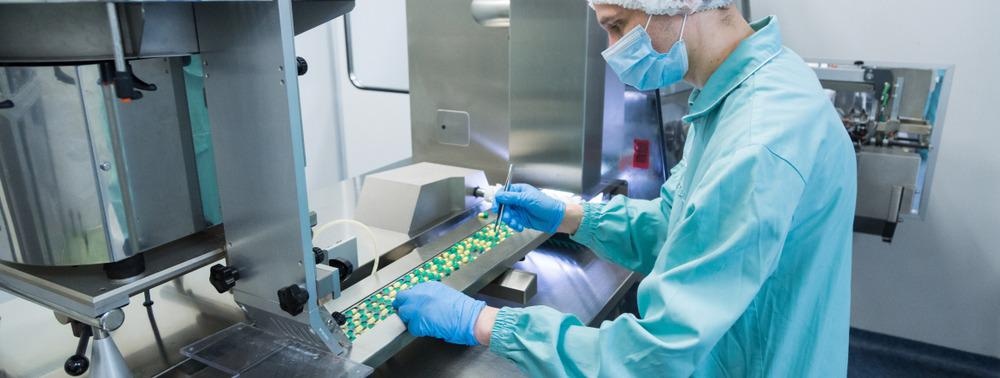One of the most challenging aspects of chemical synthesis is the purification steps required to achieve a final product with sufficiently high purity. This is even more true for the pharmaceutical industry where purity standards are necessarily more stringent as unwanted material in the final product could have potentially disastrous consequences.

Image Credit: TRMK/Shutterstock.com
There are numerous purification methods available for compound purification but one of the main challenges is finding which methods are appropriate for a given compound.1 Each purification step used for cleaning up reaction products will result in a potential loss of yield but depending on the mechanism of the separation steps used for the purification, may not actually be sufficient to separate impurities from the desired product.
Importance of Purification
Many pharmaceutical compounds are examples of chiral molecules. Unless a truly selective synthesis can be performed to only form one of the possible enantiomers, chiral products are typically formed as racemic mixtures that contain multiple enantiomeric forms.
Different enantiomers can have very different interactions with biological targets. This is an effect that was realized following the terrible consequences of the Thalidomide scandal, where the right-handed version of the drug was toxic and resulted in numerous birth defects. Thalidomide had originally been prescribed as a racemic mixture of both the left- and right-handed forms.
Purification methods for the separation of enantiomers need to use chiral stationary phases or very specific techniques which have different types of intermolecular interaction with the different enantiomers.2 If the interaction strengths are different, the amount of time it takes for one enantiomer to pass through the column takes longer than the other, then the different products can be successfully separated.
Assessing Purification
Assessment of a drug’s purity is normally carried out through a combination of spectroscopic techniques. Nuclear magnetic resonance (NMR) spectroscopy is a common choice of technique for compound analysis particularly during the synthetic process as it can provide rich information on the molecular structure but also help identify the nature of any impurities. However, NMR is not as widely used for quality control as methods such as liquid-chromatography mass spectrometry (LC-MS) coupled to UV-vis absorption spectrometers or methods such as infrared spectroscopy.3,4
NMR can be used to provide qualitative and quantitative information, and unlike UV-vis absorption-based methods, does not rely on the presence of a chromophore in the molecule. It also does not require extensive sample preparation for measurements. However, no single spectroscopic technique is suitable for purity analysis of all compounds, so often it is necessary to combine methods to profile whether a new pharmaceutical is truly pure.
Intermolecular Interactions
One type of information that can be recovered from NMR spectra is an assessment of binding energies and intermolecular interaction strengths. Many purification methods involve the use of columns that have a specific stationary phase. Purification is achieved by different chemical species having different interaction strengths with the stationary phase of the column and therefore different retention times.
As the nature and magnitude of these interactions can be difficult to predict, many scientists rely on trial-and-error approaches, previous literature data, and experience to choose the right stationary phase and solvent gradient to use in a column.
However, recent work from the Rensselaer Polytechnic Institute in collaboration with Merck Pharmaceuticals and Bio-Rad Laboratories has shown that NMR may help the pharmaceutical industry make more informed choices about their purification methods.5
NMR and Purity
The team used two-dimensional heteronuclear single quantum coherence (2D- HSQC) NMR experiments to look at the binding between IgG1 FC – a monoclonal antibody – and gold nanoparticles. By intentionally functionalizing the nanoparticles with cation-exchange ligands designed to mimic those used in multimodal ion-exchange chromatography, the team used the NMR experiments to investigate the binding interactions between the biomolecule and substrate.
From the experiments, they could identify that when the ligands were attached to the nanoparticle designed to mimic the surface-assembled monolayers of the column, the binding was stronger between the protein and ligands than it was for just the free ligands and protein in solution. The team could also see which binding sites on the IgG1 FC would interact with each specific type of ligand.
The chemical structure of the ligand was not the only factor that had an important effect on the types of intermolecular interaction and binding strengths. The team found that the ligand density on the nanoparticle surface also influenced both the binding strengths and binding regions. The magnitude of this effect was also dependent on the chemical nature of the ligand used.
Overall, by understanding these types of surface/substrate interactions, it is possible to gain a better understanding of how particular molecules will interact with a given column and therefore which separation conditions might lead to the most effective and efficient purification.
References and Further Reading
- Yan, B. (Ed.). (2004). Analysis and purification methods in combinatorial chemistry (Vol. 242). John Wiley & Sons.
- Ahuja, S. (Ed.). (2011). Chiral separation methods for pharmaceutical and biotechnological products. John Wiley & Sons.
- Holzgrabe, U. (2010). Progress in Nuclear Magnetic Resonance Spectroscopy Quantitative NMR spectroscopy in pharmaceutical applications. Progress in Nuclear Magnetic Resonance Spectroscopy, 57(2), 229–240. https://doi.org/10.1016/j.pnmrs.2010.05.001
- Luypaert, J., Massart, D. L., & Heyden, Y. Vander. (2007). Near-infrared spectroscopy applications in pharmaceutical analysis. Talanta, 72, 865–883. https://doi.org/10.1016/j.talanta.2006.12.023
- Gudhka, R. B., Vats, M., Bilodeau, C. L., Mccallum, S. A., Mccoy, M. A., Roush, D. J., Snyder, M. A., & Cramer, S. M. (2021). Probing IgG1 F C − Multimodal Nanoparticle Interactions : A Combined Nuclear Magnetic Resonance and Molecular Dynamics Simulations Approach. Langmuir, 37, 12188–12203. https://doi.org/10.1021/acs.langmuir.1c02114
Disclaimer: The views expressed here are those of the author expressed in their private capacity and do not necessarily represent the views of AZoM.com Limited T/A AZoNetwork the owner and operator of this website. This disclaimer forms part of the Terms and conditions of use of this website.